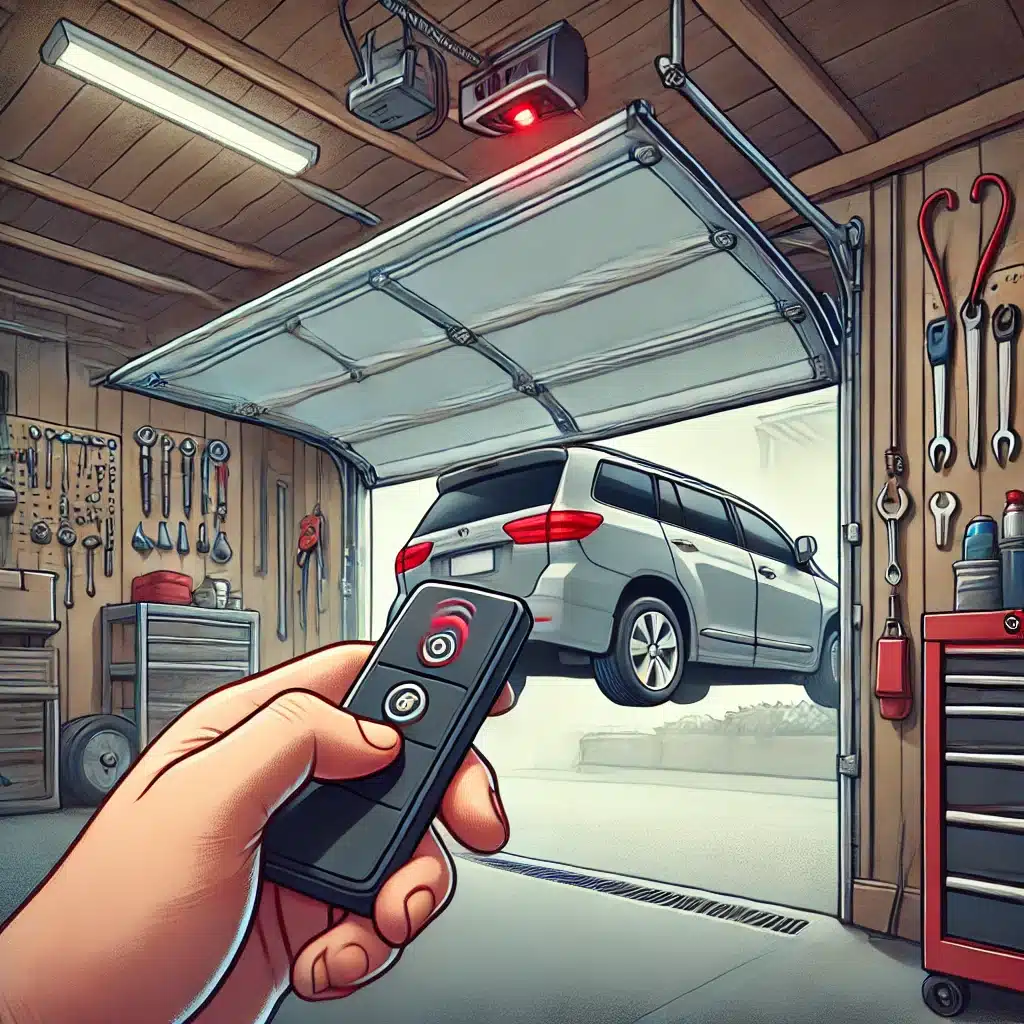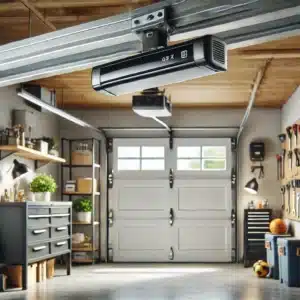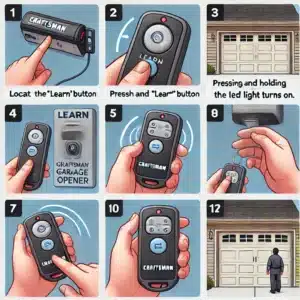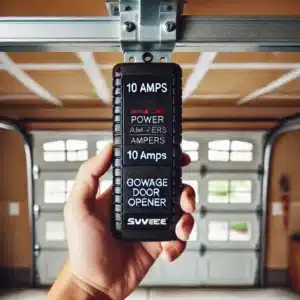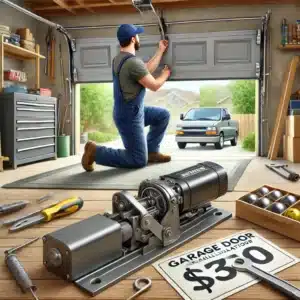Discovering that your garage door won’t close can be frustrating, especially when you’re in a rush or dealing with inclement weather. A malfunctioning garage door not only disrupts your daily routine but can also leave your home and belongings vulnerable. It’s essential to address the issue as quickly as possible to restore both convenience and security to your home.
Fortunately, most problems with a garage door that won’t close are fixable with a bit of troubleshooting. Understanding the potential causes behind this issue and knowing how to address them can save you both time and money. In this guide, we’ll walk you through the most common reasons why your garage door won’t close and offer fast solutions to get things working again.
Why Your Garage Door Won’t Close: The Most Common Causes
1. Misaligned Safety Sensors
One of the most common reasons why a garage door won’t close is due to an issue with the safety sensors. Modern garage doors come equipped with photo-eye sensors located near the base of the door’s tracks. These sensors are designed to detect any obstructions and prevent the door from closing if something is in the way. However, if the sensors become misaligned or dirty, the garage door system may mistakenly believe there’s an obstruction and refuse to close.
How to Fix It:
- Inspect the sensors located near the bottom of the garage door tracks.
- Clean the sensor lenses to remove any dirt, dust, or cobwebs that could be interfering with the beam.
- Ensure that the sensors are properly aligned. If one sensor is even slightly out of position, the door won’t close. You can realign them by adjusting the brackets until the LED lights on both sensors are solid, and not blinking.
2. Obstructions in the Garage Door’s Path
Another straightforward reason your garage door won’t close could be due to physical obstructions along the door’s path. Even small objects like leaves, debris, or loose tools can prevent the garage door from closing completely.
How to Fix It:
- Inspect the garage door’s path and remove any items or debris that could be blocking the door.
- Check the door’s tracks to ensure they are clear of dirt, debris, or other obstructions.
- Double-check that nothing is stuck to the bottom of the door that might be triggering the safety sensors.
3. Damaged or Worn-Out Tracks
If your garage door tracks are bent, warped, or otherwise damaged, this could also be the reason why your garage door won’t close. A misaligned or damaged track can prevent the door from moving smoothly, leading to operational issues.
How to Fix It:
- Inspect the tracks for any visible damage, such as bends or cracks.
- Use a rubber mallet or hammer to gently realign minor bends in the track. For more severe damage, you may need to call a professional for repairs or replacement.
- Regularly lubricate the tracks with a silicone-based lubricant to ensure smooth operation.
4. Broken Garage Door Springs or Cables
The springs and cables in your garage door system are responsible for lifting and lowering the door. If one of these components is broken or damaged, the door may become unbalanced, preventing it from closing properly. This can also pose a significant safety hazard.
How to Fix It:
- Visually inspect the springs and cables for any signs of wear, fraying, or breakage.
- If you notice damage to the springs or cables, it’s best to leave the repairs to a professional. Garage door springs are under high tension and can cause serious injury if not handled correctly.
5. Issues with the Garage Door Opener
Sometimes, the reason your garage door won’t close is tied to a problem with the garage door opener itself. This could be due to electrical issues, a malfunctioning remote control, or problems with the opener’s settings.
How to Fix It:
- Replace the batteries in your remote control to rule out a simple fix.
- Check the wall-mounted switch to ensure it’s not stuck or malfunctioning.
- Reset the garage door opener by unplugging it for about 30 seconds, then plugging it back in.
- If none of these solutions work, you may need to consult a garage door professional for more advanced troubleshooting.
6. Limit Settings are Incorrect
Garage door openers have limit settings that control how far the door should move before it closes completely. If the limit settings are off, your garage door may think it has reached the ground when it hasn’t, causing the door to stop prematurely or reverse.
How to Fix It:
- Consult your garage door opener’s manual to locate the limit adjustment settings.
- Adjust the settings gradually until the door closes properly without reversing.
How to Prevent Future Garage Door Malfunctions
Taking proactive steps to maintain your garage door is essential for preventing problems like a garage door that won’t close. Regular maintenance, cleaning, testing, and professional inspections can save you from sudden malfunctions and costly repairs. Here’s how you can effectively maintain your garage door system to ensure it operates smoothly for years to come.
Regular Maintenance
Regular maintenance is the cornerstone of preventing garage door issues. Performing periodic checks and routine maintenance tasks can help you catch potential problems before they escalate into more serious issues. Some important tasks to include in your maintenance routine are:
- Inspecting the Tracks: Check the garage door tracks for debris, dents, or bends. Tracks should be clean and properly aligned to allow the door to move smoothly.
- Examining the Rollers: Rollers can wear down over time, causing the door to become noisy or stick during operation. Inspect the rollers for signs of wear, such as cracks or chips, and replace them if necessary.
- Lubricating Moving Parts: The hinges, rollers, tracks, and springs all need proper lubrication to function correctly. Use a silicone-based lubricant for smoother operation. Regular lubrication prevents excessive friction that can lead to parts wearing down faster.
- Checking Springs and Cables: Garage door springs and cables are under a lot of tension and can break over time. Visually inspect them for signs of wear or damage, but avoid trying to fix or replace them yourself—this is a job for professionals.
By consistently performing these basic maintenance tasks, you can keep your garage door operating efficiently and reduce the likelihood of more serious issues arising.
Keep Sensors Clean and Aligned
Garage door sensors are an integral part of the system, ensuring that the door stops closing if something is in its path. Over time, these sensors can become dirty or misaligned, which can cause the door to malfunction and refuse to close. To keep your sensors functioning properly:
- Clean the Lenses: Dust, dirt, and cobwebs can accumulate on the sensor lenses, causing false signals that prevent the door from closing. Regularly wipe the lenses with a soft cloth to keep them clean.
- Check Sensor Alignment: The sensors should face each other directly, and the LED lights on both sensors should remain solid. If the lights are blinking, it usually indicates that the sensors are misaligned. Adjust the sensors manually until the lights stop blinking, ensuring the sensors are properly aligned.
Including this in your regular maintenance routine can prevent many common issues related to a garage door that won’t close. Keeping sensors clean and aligned will ensure they work as intended and keep your door functioning safely.
Test the Auto-Reverse Function
The auto-reverse function is one of the most important safety features of your garage door. It ensures that the door automatically reverses if it encounters an obstruction while closing. This feature prevents injuries and damage to vehicles or other objects in the door’s path. It’s crucial to test the auto-reverse function regularly to make sure it’s working correctly.
- How to Test the Auto-Reverse: Place a sturdy object like a block of wood or a roll of paper towels in the door’s path. Close the door, and if the system is working correctly, the door should stop and reverse when it makes contact with the object.
- Adjust if Necessary: If the door doesn’t reverse after encountering an obstruction, this could indicate a problem with the auto-reverse function or the limit settings. You may need to adjust the force settings or consult a professional to recalibrate the system.
Regularly testing the auto-reverse function ensures that your garage door operates safely and prevents potential accidents.
Hire Professional Inspections
Even with routine maintenance, there are some components of your garage door that require professional attention. Springs, cables, and the garage door opener system are under high tension and can be dangerous to repair without the proper expertise. Scheduling annual professional inspections can help identify and address issues before they cause your garage door to stop working.
- What Professionals Check: During a professional inspection, the technician will examine the springs, cables, tracks, rollers, and other mechanical parts for wear or damage. They will also test the opener and safety systems, ensuring everything is in good working order.
- Preventative Repairs: Professional inspections can catch early signs of wear and tear, such as rusted springs or fraying cables, allowing you to repair or replace parts before they fail entirely.
Hiring a professional once a year for a thorough garage door inspection ensures that all components of the system are working together properly and extends the overall lifespan of your garage door. In the long run, this will save you from unexpected malfunctions and costly repairs.
Weatherproof Your Garage Door
Weather conditions can also affect your garage door’s functionality, especially in extreme climates. Cold weather can cause metal components to contract, making the door harder to open and close, while humidity and rain can lead to rust and damage to the tracks and springs. To protect your garage door from the elements:
- Install Weatherstripping: Adding weatherstripping to the bottom of the garage door can prevent drafts, moisture, and debris from entering the garage, reducing the risk of damage.
- Inspect for Rust: Regularly check for signs of rust, particularly on metal parts like springs, tracks, and hinges. If you find rust, consider scheduling a garage door repair, then treat it with a rust remover and apply a rust-preventive lubricant to keep it from spreading.
- Adjust for Seasonal Changes: As temperatures fluctuate, the door’s limit settings may need adjustment. If the door struggles to close or seems to work harder in certain seasons, it may be due to temperature-related issues. Check the limit settings and adjust accordingly.
Weatherproofing your garage door helps maintain its durability, functionality, and energy efficiency, protecting your investment and ensuring it operates smoothly year-round.
Replace Worn Parts Before They Fail
Worn-out parts are one of the most common reasons a garage door won’t close. To avoid sudden malfunctions, it’s essential to replace worn components such as rollers, springs, and cables before they fail. Some signs of wear to look for include:
- Noisy Operation: If your garage door starts making unusual noises like grinding or squeaking, it may indicate that the rollers or hinges are wearing down.
- Slow or Jerky Movement: If the door moves slower than usual or appears to jerk as it moves, this could be a sign that parts like the springs or cables are wearing out.
- Visible Wear: Regularly inspect the springs, cables, and other moving parts for visible signs of wear, such as fraying cables or stretched-out springs.
By staying ahead of wear and tear, you can ensure that your garage door system remains reliable and safe. Replacing worn parts proactively is much cheaper and safer than dealing with a complete breakdown.
Monitor the Garage Door Opener
The garage door opener is a key part of the system, and like other components, it needs regular attention. Over time, the opener’s settings may shift, leading to performance issues such as the garage door not closing properly. To ensure smooth operation:
- Check the Battery in Your Remote: If your garage door isn’t responding properly to your remote, the issue might be as simple as a dying battery. Replace the battery if needed.
- Inspect the Opener’s Settings: Check the limit settings on the opener to ensure they are properly calibrated. Incorrect limit settings can cause the door to close too soon or fail to close completely.
- Lubricate the Opener’s Chain or Belt: Keep the opener’s chain or belt properly lubricated to ensure quiet and smooth operation.
Paying attention to the opener and addressing minor issues as they arise will keep the entire system working efficiently and prevent unexpected failures.
Frequently Asked Questions About Garage Door Won’t Close
1. Why won’t my garage door close all the way?
This can happen due to issues with the limit settings, misaligned sensors, or obstructions in the door’s path. Check these areas to troubleshoot the issue.
2. What do I do if my garage door is stuck halfway?
If your garage door is stuck halfway, it may be due to an obstruction, misaligned tracks, or broken springs. Check for any visible blockages or damage, but avoid using force to close the door.
3. How can I tell if my garage door sensors are malfunctioning?
If the garage door sensors are malfunctioning, the door may not close or may reverse when trying to close. Inspect the sensor lights—solid lights indicate proper alignment while blinking lights suggest a problem.
4. Why does my garage door start to close, then reverse?
This is often caused by an obstruction or misaligned sensors. Double-check the area around the door for any blockages and ensure the sensors are properly aligned.
5. Can I fix a garage door that won’t close by myself?
Some minor issues like cleaning sensors or adjusting limit settings can be done yourself. However, more complex repairs involving springs, cables, or the door opener may require professional assistance.
Conclusion
A garage door that won’t close can disrupt your routine and compromise the safety of your home. The good news is that many of the common causes—such as sensor misalignment, track obstructions, and simple opener settings—can be fixed quickly. However, if the issue is more serious, like broken springs or damaged cables, professional help is necessary to avoid further damage or injury.
Family Prestige Garage Doors is here to provide expert assistance for all your new garage door needs. From routine maintenance to emergency repairs, we can ensure your garage door operates smoothly and safely.
End Note
Family Prestige Garage Doors is dedicated to protecting your home and enhancing its curb appeal with customized garage door solutions. Whether you need repairs, a new installation, or regular maintenance, our team offers reliable service and unmatched quality. Learn more about us on our About Us page, explore the full range of Garage Door Services, and check the areas we serve through our Service Area page. We also provide Financing options to fit your budget. For inspiration, visit our Gallery, and stay informed with our latest updates by reading our Blog. To get started, Contact Us today for more information or to schedule a consultation.

